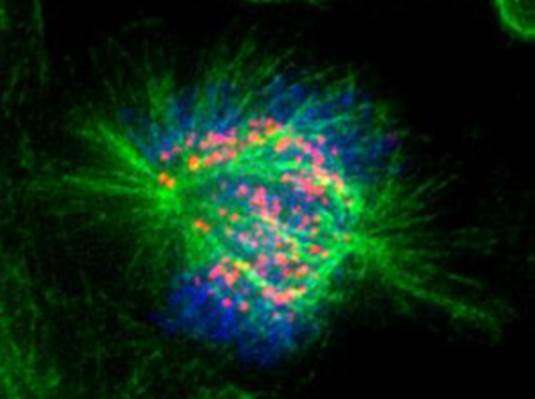Study finds cell division sign posts for chromosomes along microtubule highway

A system within cells that guides how chromosomes move during cell division was discovered by researchers led by co-senior authors Ekaterina Grishchuk, PhD, an assistant professor of Physiology at the Perelman School of Medicine at the University of Pennsylvania, and Helder Maiato, from the Universidade do Porto, Portugal.
The team found that specific chemical signals on microtubules—which work as an intracellular highway—give directions to chromosomes as to which route to take during cell division. They described their findings this month in Science.
Microtubules are components that give structure to and organize a cell. They are also the main intracellular transport network. Motor proteins move along the microtubules ferrying chromosomes undergoing mitosis (part of cell division) as well as other subcellular organelles. How motor proteins navigate chromosomes along the highway during cell division was unclear, until now. The team discovered marks that label microtubules to direct the way in which a chromosomal motor protein should proceed.
During cell division, chromosomes move on special spindle microtubules to align themselves, so they can split equally between the two resulting daughter cells. The team demonstrated that chromosome motion for this alignment is controlled by a specific post-translational modification of tubulin, the protein building block of microtubule tracks.
The Grishchuk lab showed that transport by a molecular motor protein called CENP-E kinesin is strongly enhanced on certain microtubule tracks. "This biophysical study was complemented by cell biological experiments carried out by the Maiato lab in Portugal, leading to the discovery that CENP-E-kinesin motors failed to take chromosomes to their alignment position if the guiding marks were eliminated," explains Grishchuk. "This discovery became possible due to our use of high-resolution laser trapping techniques, which enable observing motions and forces at a single molecule level. With these multidisciplinary approaches, we hope to gain understanding of the mechanisms that ensure a high fidelity of chromosome segregation in dividing cells and learn how pathological chromosomal instability can be prevented."
More information: "Microtubule Detyrosination Guides Chromosomes During Mitosis." Science 15 May 2015: Vol. 348 no. 6236 pp. 799-803 DOI: 10.1126/science.aaa5175
Journal information: Science
Provided by University of Pennsylvania School of Medicine
















